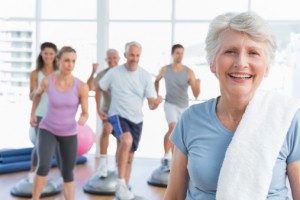

 It’s no secret that exercise is good for us, but as we age we tend to shy away from exercise because it becomes a little harder. Something as simple as bending down to tie a shoe can be challenging for some older people, but exercise is just as important as we age according to mounting research.
It’s no secret that exercise is good for us, but as we age we tend to shy away from exercise because it becomes a little harder. Something as simple as bending down to tie a shoe can be challenging for some older people, but exercise is just as important as we age according to mounting research.
More and more evidence seems to suggest that the best prescription for healthy, successful aging is exercise for fitness. Research in the United States, Canada and Europe indicates that the benefits of exercise as we age are not only physical but mental, too.
A study conducted in the Archives of Internal Medicine confirms working out at the gym on a regular basis not only helps seniors maintain good overall health, but can assist in preventing the onset of chronic diseases like heart disease and osteoarthritis. Meanwhile, researchers at the University of British Columbia discovered that a group of older people who participated in year-long resistance training once or twice a week performed better on memory and learning tests than those who did not exercise. These are just two examples of the many studies that support the benefits of exercise as we age.
As we age, we lose muscle mass and strength and this can impact our balance. Many people at this stage in their lives fear exercise for fitness because they think they will fall. What they don’t realize is that exercise can in fact help us develop muscle mass and strength, thus building stamina to prevent bad balance and falls. Studies show that the benefits of exercise far outweigh the negative risks. Another issue with exercise as we age is fatigue. Many elderly people feel as if they just don’t have the energy to participate in active movement like they did when they were younger. While it may be true that some people can’t continue to take part in vigorous exercise routines, moderate or low-impact exercise is often still possible.
Since energy level can be an issue for older adults, getting a boost from healthy, nutritious snacks is a good way to increase motivation and make it through an exercise routine.
Here are a few foods that can help keep people energized for exercise:
There are numerous age-appropriate exercises to choose from. Swimming, walking, hiking, tennis, light jogging, cycling and golf (without a cart) are a few examples.
In 2007, both the College of Sports Medicine and the American Heart Association updated their Physical Activities Guidelines for people over 65. For moderate exercise, such as brisk walking or cycling, they recommend 30 minutes per day, five days a week. That can also be broken up into shorter workouts of 10 minutes each. For vigorous exercise, the suggestion is 20 minutes per day, three days a week.
Balance exercises are important. One out of three people over the age of 65 experience some kind of fall each year. Here are a few exercises to improve balance and avoid falling:
No one denies the benefits of exercise for children and young adults, but in recent years there has been a lot of research conducted on the impact of sedentary behavior on successful aging. There is overwhelming evidence that lack of exercise not only leads to falls, but also can contribute to premature aging, chronic disease and mortality. For instance, in 2013 the American Journal of Preventative Medicine published the results of a large study that linked sedentary women aged 50-79 to higher risk of mortality. The U.S National Library of Medicine published an article in 2010 that shows men up to 89 years old have a much higher risk of death due to cardiovascular disease from a sedentary lifestyle.
The older we get, the harder exercise can be, but as Greek philosopher Plato once said, “Lack of activity destroys the condition of every human being, while movement and methodical physical exercise save it and preserve it.”
The simple trick to better digestion
A strong core comes with many benefits, like reducing your risk of injury (you’ll lower your risk of falls!), better protection for organs such as intestines and nervous system, reduced back pain and even improvements on your posture. Continue reading…
Seniors: Exercise boosts brain health
Researchers at the University of Kansas Medical Center have shown that seniors can greatly benefit from exercise when it comes to boosting brain health. Continue reading…
Copyright © www.orthopaedics.win Bone Health All Rights Reserved